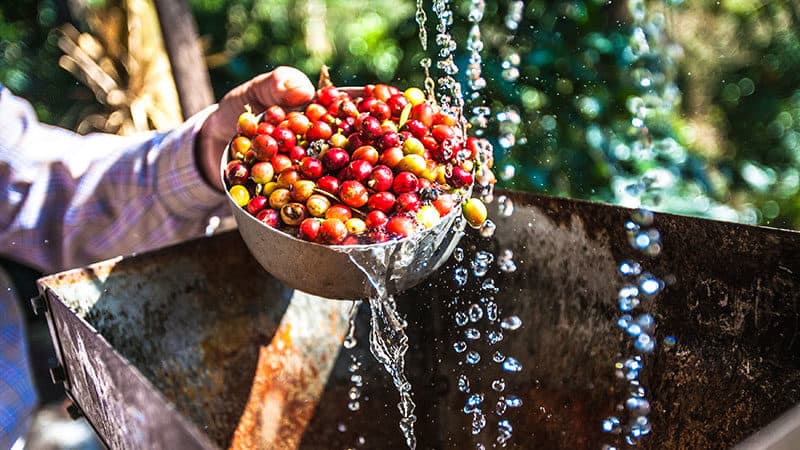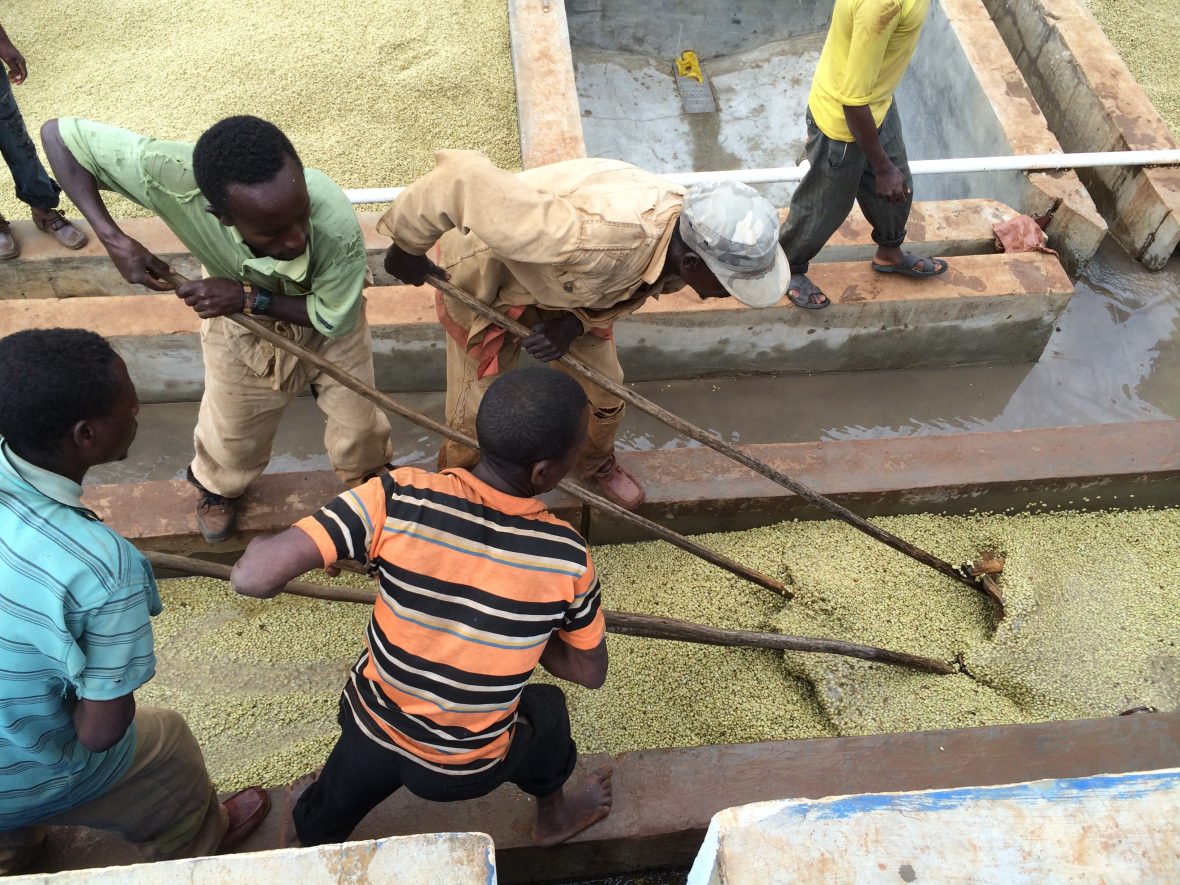Explain in detail the water washing method of coffee and raw beans: how long is the water washing method? What are the precautions?
Professional coffee knowledge exchange more coffee bean information please follow the coffee workshop (Wechat official account cafe_style)
Every coffee producer needs to understand several factors that affect coffee quality, namely, manor management, raw bean treatment after coffee harvest, coffee roasting, and coffee brewing. Each of these four stages will affect the quality of coffee.
Coffee producers may not specialize in coffee roasting or accurately brew coffee, but they can not ignore the management of coffee estates, let alone ignore the processing and production of coffee fruits after harvest. Only by using proper post-processing is it possible to make a good coffee that is satisfactory.

The Evolution History of Coffee and Raw Bean treatment-from Solar to Water washing
At first, coffee fruits were harvested as long as they were laid in the sun until they were dried, which was the sun drying method. Very little water is used in the whole process. It is a way that can be operated by ordinary producers.
When the exocarp is peeled off, the producer is expected to shorten the drying time and reduce the mildew and other bad odors caused by damp rain in the sun process. But did not expect that the layer of colloid in the pericarp is more difficult to deal with. Therefore, I think of the method of removing gelatinous bodies with water, because gelatinous bodies are mainly composed of pectin and sugar and are easily dissolved in water. After removing the gelatin, the coffee beans are easy to dry and clean and easy to operate.

Therefore, in the early stage, it was thought that the purpose of fermentation was to remove colloid. After removing the colloid, the coffee beans are easy to dry and shorten the production time, resulting in a relatively large increase in production capacity. As a result, there are many super-large washing treatment plants, which also turn the post-processing into a kind of professional technology and equipment that producers can not touch. In order to increase production capacity, in order to shorten the technological process, resulting in a lot of biological or chemical additives degumming method, combined with the application of drying machinery and equipment. The focus of this process is only on the mass production of raw coffee beans. Most producers retreated to the role of coffee fruit supply and did not have the opportunity to participate in post-processing.

However, a large number of washed raw beans are produced, which relatively produces a large amount of waste water. The waste water discharged from coffee washing and treatment plants seriously pollutes streams in important coffee producing areas.
In recent years, as the coffee consumer market is tired of the mediocre quality of large-scale production of washed beans, there is a growing demand for the improvement of coffee quality. Coffee quality improvement has become an important topic in various international discussions. in various resolutions, there are often plans to eliminate inferior varieties, to upgrade high-quality coffee varieties, and to improve the treatment of raw coffee beans to improve coffee quality. With the introduction and completion of the definition of boutique coffee specialty coffee, more attention has been paid to the selection of coffee varieties, and various exquisite processing methods have gradually taken shape.

Fermentation no longer focuses on removing colloid, but strengthening fermentation itself may increase the possibility of improving the quality of coffee. Emphasis is placed on finding the colloid inside the coffee fruit, which plays a role in affecting the quality of coffee. Therefore, the understanding of fermentation is no longer to remove the colloid, but what chemical changes have taken place in the whole fermentation process, which chemicals have been produced? And which chemicals are helpful to improve the quality of coffee? Which chemicals have a negative effect on the quality of coffee?
Although with the rise of exquisite sun and unique honey treatment methods, water-washed beans appear less and less on the international top stage, but this does not mean that the water-washing method is useless, nor does it mean that the water-washing method will be eliminated by the times. On the contrary, most coffee producing areas in the world still use water washing method, and begin to adapt measures to local conditions, evolving a variety of unique water washing treatment methods.

1. The first is the general washing type:
[natural fermentation water washing treatment method A] process: harvest → peeled → natural fermentation 12-24 hours → washing → sun drying
[natural fermentation water washing method B] process: harvest → peeled → natural fermentation 12-24 hours → wash → soak in clear water 24 hours → sun drying
After harvest, the fruits with high quality and maturity are selected, peeled, fermented naturally for 12-24 hours, cleaned, soaked in water for 24 hours, washed and dried in the sun.
Note: the fermentation time at normal temperature is enough for one night, about 12-15 hours. It depends on the situation, it doesn't have to ferment to 24 hours.

two。 The second is the washing treatment of Rwandan coffee:
[Rwanda natural fermentation water washing method] process: harvest → peeled → natural fermentation 12 hours → washing → soaking water fermentation 24 hours → washing → soaking water 24 hours → sun drying
After harvest, the fruit with high quality and maturity is selected, peeled, fermented naturally for 12 hours, cleaned, fermented for 24 hours for the second time, cleaned, soaked in water for 20 hours, and dried.
3. The third is the so-called Kenyan double washing method:
[Kenya natural fermentation water washing method] process: harvest → peeled → natural fermentation 12 hours → wash → natural fermentation 24 hours → washing → soaking water 24 hours → sun drying
After harvest, the fruit with high quality and maturity is selected, peeled, naturally fermented for 12 hours (to reach pH 4.5-4.8 whichever is whichever is), washed (80-90% colloid removed), naturally fermented for 24 hours, washed, soaked in water for 24 hours (water surface 5-7 cm), and dried.

Several points for attention in washing raw coffee beans:
1. Pay attention to the maturity of the coffee fruit, use the sugar meter (diopter) to determine the refraction of the colloid as a reference, more than 18-20 indicates that the sugar content is sufficient, which is the best maturity fruit.
two。 For the selection of fruits after harvest, inferior beans need to be removed after peeling, and inferior beans still need to be picked out in the drying process.
3. The second and third methods both cut the fermentation into two times, and the first fermentation time is 12 hours. In terms of natural fermentation, it normally takes only 6-8 hours to have a good fermentation performance. After 3-4 times of full stirring fermentation, the coffee beans are fermented for 12 hours to achieve the overall full uniform fermentation effect. About 80-90% of the colloid can be removed by the first fermentation, and after cleaning, the second fermentation can be carried out to remove the remaining colloid. There is not much colloid in the second fermentation, such as the Rwandan style, although there is water-soaking fermentation, the chance of producing odor has been greatly reduced.
4. During the fermentation process, the development of pH was tracked by pH meter, which can be used as a reference for fermentation degree. Generally, pH4.5-4.8is used for fermentation, and cleaning work is carried out immediately. However, pH4.5-4.8is only used as a reference for observing the degree of fermentation and may not be related to the best quality of coffee. Ask the raw bean processor to think about this meaning. The measured value of pH4.5-4.8indicates a critical point, which is greater than this critical point, which is the process of alcohol fermentation; less than this critical point, it indicates that the acidity of the solution increases and has entered the process of extreme acetic acid fermentation. Please remember that fermentation refers to alcohol fermentation (sugar decomposition) and lactic acid fermentation (lactose decomposition). Acetic acid fermentation should be avoided. These values are not only experience, but also have a theoretical basis, and are by no means nonsense.

5. Finally, soak the fermented and washed beans in water, the main purpose is to improve the quality of the coffee beans and make the raw coffee beans show a perfectly consistent blue-green hue. Early research papers mentioned that after washing coffee beans, if it is inconvenient to shop and dry in cloudy and rainy days, they can be soaked in clean water for one or two days and then sunny, which has little effect on the quality of raw beans. Here, this process becomes an important step in improving the color and stable quality of raw beans.
6. For a more accurate understanding of fermentation, please refer to several important principles such as alcohol fermentation, acetic acid fermentation, and odor generation in the fermentation process.

7. In order to understand the difference of soaking coffee beans in different stages, coffee beans with colloid and those without colloid can be soaked in water for 12 hours, 24 hours and 36 hours, respectively. Compare the evolution differences between the two. After making this observation, it will add several times the power to the processing of raw coffee beans.
8. Special warning: the time figure in the technological process is only a reference value, not an absolute value. Practitioners should find out the appropriate time value of their location and season.
END
Important Notice :
前街咖啡 FrontStreet Coffee has moved to new addredd:
FrontStreet Coffee Address: 315,Donghua East Road,GuangZhou
Tel:020 38364473
- Prev

Coffee blossoms in Hong Kong Coffee blossoms are so cute that they can't bear to drink the origin of Coffee blossoms
Professional coffee knowledge exchange more coffee bean information please follow the coffee workshop (Wechat official account cafe_style)
- Next

Introduction to the Flavor characteristics of Water-washed Coffee beans
Professional coffee knowledge exchange more coffee bean information please follow the coffee workshop (Wechat official account cafe_style)
Related
- What is the meaning of lactic acid fermentation with coffee bean treatment?
- How to judge the state of foam by sound?
- How does the latte pull out the unicorn pattern? Come to get for a little trick to improve the flower pull!
- Will flower pulling affect the taste of the latte?
- Do you know the history of coffee?
- The difference between honey treatment and sun washing what is raisin honey treatment?
- What kind of milk can a novice use to make coffee foam to keep the foam longer? The correct method and skills of milking tutorial sharing
- Why do washed coffee beans taste sour? Flavor characteristics of washed Coffee
- Introduction to the skill of how to practice the size and height of water injection around the circle of hand-brewed coffee
- How do beginners practice coffee flower drawing from scratch?

